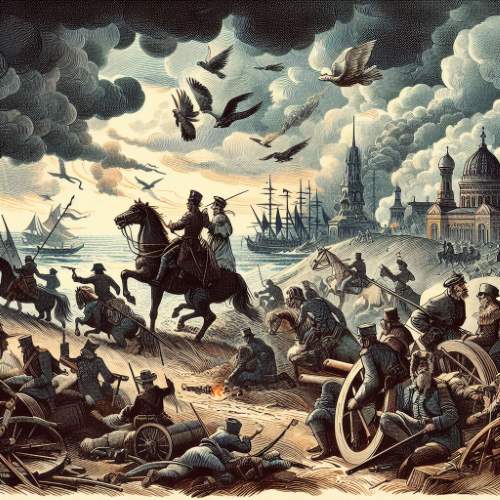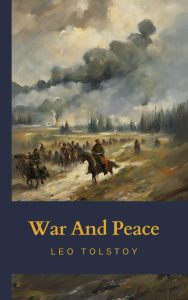
If you are here, it must be because you have some interest in reading War and Peace, one of the greatest novels of all time.
Countless readers have been drawn to its immersive portrayal of Russia during the reign of Emperor Alexander I and grappling with timeless questions about humanity’s interplay with historical forces. While its massive scale and complexity present formidable barriers to completing, the work’s unparalleled insights await those willing to rise to its challenges. This guide aims to provide practical strategies to help you start and finish this masterwork in a steady yet enjoyable manner.
The strongest of all warriors are these two — Time and Patience.
Bk. X, ch. 16 of War & Peace
I think everyone knows War and Peace by Leo Tolstoy is a long book. It is a shame that because of its length many people won’t finish it or even bother starting it.
War and Peace intimidates even the most avid readers. At over 1,200 pages, it is undoubtedly a massive undertaking. Simply seeing the physical size of the book is enough to discourage many from attempting such a literary mountain.
Download War & Peace by Leo Tolstoy For Free

Leo Tolstoy’s iconic novel War and Peace is now available to download completely free of charge in both EPUB and PDF formats. At well over a thousand pages, it may seem like a daunting read. However, for those willing to take their time with its epic story and complex characters, the experience can be particularly rewarding.
Why not give it a go by clicking the button to download this classic work today?
War & Peace Wasn’t Written To Be Read In One Go
However, it is worth considering that the book wasn’t really published to be read in one stretch. War and Peace first appeared in a Russian monthly journal from 1865 to 1869, with each new installment eagerly anticipated by subscribers. In this original serial form, readers would have experienced the unfolding narrative episodically over time rather than attempting to consume it in one sitting.
This more gradual method of release mirrors how a television series might air today. Viewers don’t typically watch all episodes back-to-back, but instead have weekly or monthly breaks between each new segment. This allows time for digestion and discussion between intervals. Likewise, parsing out War and Peace in sections may have felt more natural given the publishing conventions when it first emerged.
The Chapters Are Shorter Than You Think
Hardly any chapter breaks the 15 page mark, with many clocking in at just 5-10 pages. This means you can tackle one here and there, say over your lunch break or before bed, without a huge time commitment each sitting. Before you know it, you’ll have powered through dozens and be well on your way to conquering the whole thing quicker than you thought.
It’s worth noting that War and Peace is divided into 15 books and 2 epilogues, with each book comprising around 15-30 chapters. This structure lends itself well to alternating War and Peace with other reading materials.
Much like the original serial readers, modern audiences could take breaks between each book section to read other works. For example, one may read Book 1 of War and Peace, then a short story collection, then return to Book 2. This allows brief palate cleansers without losing momentum on Tolstoy’s work. It also helps mitigate challenges like information overload by spacing out consumption.
Interleaving other books in between parts of War and Peace makes the epic novel feel more approachable as just one of several reads in progress. Readers have the flexibility to dictate their own schedules and levels of dedication. The convenient breaking points allow natural intervals that mirror how serialization would have offered respite for initial audiences as well. Viewing it as a longer term project interspersed with other materials may be the key to helping many finally start and finish War and Peace.
How To Actually Finish War & Peace
Here are some tips for starting and finishing War and Peace:
- Don’t feel like you need to read it cover to cover without breaks. Take advantage of the built-in stopping points between each book.
- Dedicate a set amount of time each week to reading, such as an hour a few nights per week. This prevents it from feeling like a constant slog.
- Use the book divisions to intersperse your reading with other materials. Read one War and Peace book then a short story collection, for example.
- Have a notebook or digital file to take notes on characters, places, historical events to reference later. This helps retain important details.
- Don’t get discouraged if you need to re-read parts. The multiple storylines require attention and may warrant review.
- Listen to an audiobook version during commutes or chores to advance the story at a more relaxed pace.
- Take your time to savor Tolstoy’s prose and philosophical passages rather than focus on just plowing through plot.
- Read a synopsis of the historical context and characters online in advance for necessary background.
- Celebrate small victories like finishing each part by rewarding yourself, whether a sweet treat or extra leisure activity.
- Remind yourself of why you’re drawn to the story when motivation lags – its insights into history and human nature are timeless.
The keys are dividing it manageably, maintaining a consistent reading schedule, and not pressuring yourself during the substantial but worthwhile journey.
